5 Norges Bank´s conduct of monetary policy
5.1 Introduction
This chapter contains the Ministry of Finance’s evaluation of Norges Bank’s conduct of monetary policy in 2011. Such a discussion of monetary policy has been included in the annual financial markets reports to the Storting for many years. To provide a basis for the evaluation, the chapter begins with a description of the monetary policy guidelines. This is followed by an account of how monetary policy has been exercised in 2011, and a discussion of assessments undertaken by various other institutions. The chapter concludes with the Ministry’s evaluations.
5.2 Monetary policy guidelines
According to section 1 of the Norges Bank Act, Norges Bank shall be an executive and advisory body for monetary, credit and foreign exchange policy. The Bank shall issue banknotes and coin, and promote an efficient payment system. Moreover, it shall monitor developments in the money, credit and foreign exchange markets.
The current monetary policy guidelines were laid down in regulations adopted by Royal Decree on 29 March 2011 under the power granted in section 2, third paragraph, and section 4, second paragraph, of the Norges Bank Act; see Box 5.1. The reasons for and an explanation of the guidelines were provided in Report No. 29 (2000–2001) to the Storting on economic policy guidelines, issued the same day.
Boks 5.1 Regulation on Monetary Policy
Established by Royal Decree of 29 March 2001 pursuant to Section 2, third paragraph, and Section 4, second paragraph, of the Act of 24 May 1985 no. 28 on Norges Bank and the Monetary System.
I
§ 1.
Monetary policy shall be aimed at stability in the Norwegian krone’s national and international value, contributing to stable expectations concerning exchange rate developments. At the same time, monetary policy shall underpin fiscal policy by contributing to stable developments in output and employment.
Norges Bank is responsible for the implementation of monetary policy.
Norges Bank's implementation of monetary policy shall, in accordance with the first paragraph, be oriented towards low and stable inflation. The operational target of monetary policy shall be annual consumer price inflation of approximately 2.5 per cent over time.
In general, the direct effects on consumer prices resulting from changes in interest rates, taxes, excise duties and extraordinary temporary disturbances shall not be taken into account.
§ 2.
Norges Bank shall regularly publish the assessments that form the basis for the implementation of monetary policy.
§ 3.
The international value of the Norwegian krone is determined by the exchange rates in the foreign exchange market.
§ 4.
On behalf of the State, Norges Bank communicates the information concerning the exchange rate system ensuing from its participation in the International Monetary Fund, cf. Section 25, first paragraph, of the Act on Norges Bank and the Monetary System.
II
This regulation comes into force immediately. Regulation no. 0331 of 6 May 1994 on the exchange rate system for the Norwegian krone is repealed from the same date.
According to the regulations, Norway’s monetary policy must aim to secure stability in the national and international value of the Norwegian krone. The operational implementation of monetary policy must therefore focus on low, stable inflation, defined as annual growth in consumer prices which over time is close to 2.5 percent. The regulations state that monetary policy must help to stabilise output and employment trends, and simultaneously promote stability in expectations regarding exchange rate trends. Report No. 29 (2000–2001) to the Storting further stated that Norges Bank must adopt a forward-looking approach when setting the interest rate, and take sufficient account of uncertainty associated with macroeconomic forecasts and assessments. When the Executive Board of Norges Bank sets the interest rate, it must take into account that it may take time for changes in policy to take effect. In addition, the board must ignore disruptions of a temporary nature which it believes will not influence the underlying growth in prices and costs.
The long-term task of monetary policy is to help give the economy a nominal anchor point. The regulations established flexible inflation targeting as a guideline for monetary policy. In the short and medium term, monetary policy must balance the consideration of low, stable inflation with the consideration of stability in output and employment. Often, there is no conflict between these two considerations. If a conflict arises, Norges Bank must exercise discretion and weight the two considerations against one another.
5.3 The conduct of monetary policy in 2011
5.3.1 Instruments and balancing exercises in the context of monetary policy
The most important instrument in the conduct of monetary policy is the key policy rate, i.e. the interest rate on banks’ overnight deposits with Norges Bank. In normal circumstances, changes in the key policy rate have a fairly strong effect on the very short-term money market rates, i.e. daily and weekly rates. Market rates with longer terms are influenced by the level of the key policy rate and by the expectations of market participants regarding the future development of the key policy rate. This is closely linked with what market participants expect with regard to growth in output and price rises.
In the autumn of 2008, the link between the key policy rate and market rates was disrupted as a result of the international financial crisis, and at times the money market failed to function. High risk premiums had the consequence that money market rates were much higher than the expectations of market participants regarding the key policy rate; see Figure 5.1. Norges Bank and the political authorities therefore implemented several measures to improve the situation in the money and credit markets; see the detailed discussion in Chapter 2 of this report. Norges Bank injected much more krone liquidity than normal, both through ordinary fixed-rate loans (F-loans) and through currency swap agreements. In addition, auctions of dollar liquidity secured necessary dollar funding for Norwegian banks.
The situation in the financial markets improved throughout 2009 and the first half of 2010. Premiums in the money market fell sharply, and approached more normal levels. Norges Bank then normalised liquidity and phased out the extraordinary measures. Turbulence returned when certain countries in the Euro area experienced problems in repaying their debts, and premiums rose again, starting in the summer of 2010. Premiums settled down in the first half of 2011, but began to rise yet again when turbulence returned to the Euro area in the summer of 2011. At the end of 2011, the difference between the expected key policy rate and the three-month money market rate in Norway was more than one percentage point. In this regard, Norges Bank wrote in its 2011 Annual Report:
“The rise in money market premiums coincided with a deterioration in the funding situation for European banks. Activity in the bank bond market was considerably lower in the second half of 2011. This also influences the costs facing Norwegian banks seeking market funding”.
On 3 October 2011, a new system for managing bank liquidity was introduced. Under the new system, banks receive only a certain quota which bears interest at the key policy rate. Deposits in excess of the quota bear interest at the reserve rate, which is one percentage point lower than the key policy rate. The purpose of the new system is to promote lending activity in the internal bank market. Simultaneously with the introduction of the new system for liquidity management, Norges Bank began to list the “NOWA rate”. NOWA is a weighted average of actually traded unsecured overnight loans between Norwegian banks. Since Norges Bank began listing the NOWA rate, the rate has been a little more than one basis point lower than the key policy rate, on average.
On Norges Bank’s initiative, Finance Norway (FNO), in cooperation with the banks, developed rules for the setting of the NIBOR rate, with the aim of making the setting process more transparent. The new rules contain, among other things, a clear definition of this reference rate and how it should be interpreted in relation to corresponding rates in other countries.
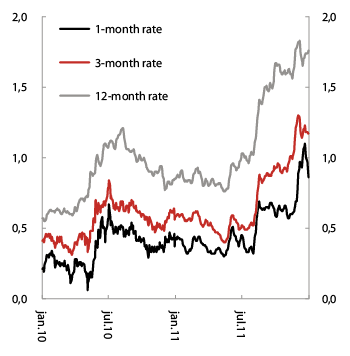
Figur 5.1 1 Spread between money market rates and the expected key policy rate. Percentage points. Five-day moving average. 1 January 2010–31 December 2011.
1 Figure 5.1 is identical to Figure 2.8 in the 2011 Annual Report of Norges Bank.
Kilde: Thomson Reuters and Norges Bank
Market expectations regarding the key policy rate depend on the market participants’ beliefs concerning economic developments, particularly in relation to growth and price rises, and their view on the central bank’s future actions in the monetary policy context. Market rates influence the krone exchange rate, the prices of securities, housing prices and demand for loans, investment and consumption. Norges Bank’s key policy rate may also influence expectations regarding economic developments and future inflation. Through all of these channels, the interest rate influences the total demand and output situation, and prices and wages.
In its 2011 Annual Report, Norges Bank wrote, among other things, the following about flexible inflation targeting:
“Norges Bank operates a flexible inflation targeting regime, so that interest rate setting gives weight to smoothing fluctuations both in inflation and in output and employment. Flexible inflation targeting builds a bridge between long-term objective of monetary policy, which is to keep inflation low and anchor inflation expectations, and the objective of smoothing developments in output”.
Three times a year, a Monetary Policy Report is published, simultaneously with the publication of interest rate decisions by the Executive Board. In the reports, Norges Bank analyses the economic situation and makes forecasts of economic developments and the key policy rate. Based on the analyses, the Executive Board adopts a monetary policy strategy in the form of an interval for the key policy rate for the period before publication of the next Monetary Policy Report.
If monetary policy is to be credible in view of the assumptions made by Norges Bank regarding economic developments, the Bank’s interest rate forecast must achieve a reasonable balance between the different considerations which monetary policy must take into account. If Norges Bank’s monetary policy actions are regarded as stable and credible, the effect of monetary policy is also strengthened. Norges Bank has developed a set of criteria for what the bank considers to be a good future development of the interest rate. The criteria are discussed in the Monetary Policy Reports.
The implementation of monetary policy requires good access to information about economic developments. In the autumn of 2002, Norges Bank established a regional network composed of firms and public enterprises to gather information about output and price trends and planned future investments and employment levels. Around 1,500 contacts are linked through this network. Along with available official statistics, the reports from the regional network constitute an important part of the Bank’s decision-making basis.
5.3.2 Monetary policy in 2011
Monetary policy takes effect with a time lag. Developments in inflation, output and employment in 2011 are therefore also influenced by the monetary policy pursued in preceding years.
At the beginning of 2011, the key policy rate was 2.00 percent. At the interest rate meeting in May, the Executive Board decided to raise the interest rate to 2.25 percent; see Table 5.1. The interest rate was then kept stable until the meeting in the middle of December, when it was cut to 1.75 percent.
Tabell 5.1 Interest rate decisions of the Executive Board of Norges Bank in 2011
Interest rate meeting | Change in percentage points | Key policy rate after the meeting |
|---|---|---|
26 January | 0.00 | 2.00 |
16 March | 0.00 | 2.00 |
12 May | 0.25 | 2.25 |
22 June | 0.00 | 2.25 |
10 August | 0.00 | 2.25 |
21 September | 0.00 | 2.25 |
19 October | 0.00 | 2.25 |
14 December | -0.50 | 1.75 |
The Executive Board’s strategy for the development of the key policy rate, as set out in Monetary Policy Report 3/10, was that the key policy rate should lie in the interval 1½–2½ percent in the period to the publication of the next report in March 2011, unless the Norwegian economy was exposed to new major shocks. According to the Bank, until the interest rate meeting on 26 January, the Norwegian economy grew largely as assumed in October. Accordingly, the Executive Board decided to keep the key policy rate unchanged at 2.00 percent at the interest rate meeting in January.
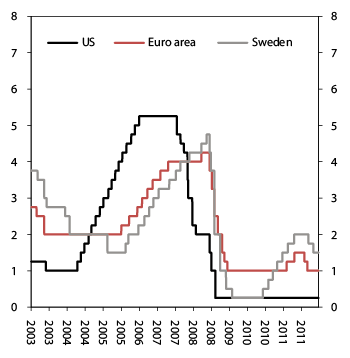
Figur 5.2 Key policy rates in selected countries. 1 January 2003–18 April 2012. Percent.
Kilde: Reuters Ecowin
During the period which followed, the upturn in the Norwegian economy continued. According to the Bank, global economic growth was somewhat stronger than predicted in Monetary Policy Report dated October 2010, while a strong rise in the prices of oil, food and other raw materials had resulted in higher consumer price growth in many countries. The market therefore had increased expectations of interest rate rises. Norges Bank’s Executive Board kept the key policy rate unchanged at the interest rate meeting on 16 March. In Monetary Policy Report 1/11, which was published on the same day, it was assumed that the key policy rate would be increased gradually over time. The strategy of the Executive Board was now that the key policy rate should lie in the interval 1¾–2¾ percent in the period to the publication of the next report in June. Norges Bank’s interest rate path in Monetary Policy Report 1/11 indicated an average key policy rate of 3.9 percent in the fourth quarter of 2012, and 4.7 percent in the fourth quarter of 2013. This meant an increase of ½ percentage point compared to Norges Bank’s interest rate path of October of the previous year. The key policy rate forecast stated that the interest rate would be raised by 0.75 percentage points during 2011.
Throughout the spring of 2011, global economic growth continued, particularly in emerging economies. Improved trends internationally led institutions like the European Central Bank and Sweden’s Riksbank to raise their key policy rates in April. At the interest rate meeting in May, Norges Bank considered capacity utilisation in the Norwegian economy to be close to a normal level. Price rises were low, but in Norges Bank’s view there were indications that the growth in prices would rise in future. At the interest rate meeting in May, the Executive Board decided to raise the key policy rate to 2.25 percent. In its explanation, the Executive Board pointed to, among other things, the need to stabilise activity and inflation some way into the future. The decision was consistent with the interest rate path described by Norges Bank in the March Monetary Policy Report.
Ahead of the interest rate meeting in June, Norges Bank considered the prospects of the global economy to be more uncertain. In the Bank’s opinion, capacity utilisation in Norway was close to a normal level, while wage growth was higher and unemployment lower than the Bank had expected in March. According to the Bank, the difference between developments in Norway and developments internationally presented a risk that the krone would strengthen. Norges Bank therefore saw reason to proceed carefully in raising interest rates. At the interest rate meeting in June, the Bank decided to keep the key policy rate unchanged at 2.25 percent. Norges Bank’s interest rate path was little changed in Monetary Policy Report 2/11 compared to the March report. The forecast indicated that the interest rate would be raised at the next interest rate meeting in August.
During the summer, the prospects for the global economy worsened considerably. Despite the implementation of extensive measures by the Euro countries and the European Central Bank, the financial markets were marked by significant turbulence. Interest rates on the government bonds of debt-exposed countries in Europe increased substantially. Expectations regarding key policy rates abroad fell markedly. The turbulence spread to the money markets, where risk premiums increased. The premium in the money market also increased in Norway, and the krone exchange rate fluctuated widely. Norges Bank considered the risk that the debt crisis in the Euro area would have large, long-term effects on economic development to be greater than before the summer. At its interest rate meeting in August, Norges Bank decided not to increase the key policy rate. Thus the rate was somewhat lower than the level indicated by the reference path in Monetary Policy Report 2/11.
According to Norges Bank, economic growth in Norway until September was somewhat weaker than expected. Measured using CPI-ATE, the underlying price growth in September was 0.9 percent. Following an overall assessment, the Executive Board of Norges Bank decided to keep the key policy rate unchanged at 2.0 percent at the interest rate meeting in September. In its press release, Norges Bank wrote:
“There is an unusually high level of uncertainty surrounding the key policy rate ahead. If price and cost inflation moves up and growth prospects improve, the key policy rate may be raised. If the Norwegian economy is exposed to new major shocks, with a further deterioration in the outlook for growth and inflation, the key policy rate may be reduced”.
By the time Norges Bank was to publish a new Monetary Policy Report in October, the prospects had changed substantially compared to when Monetary Policy Report 2/11 was presented in June. Growth in trade partners was lower, the sovereign debt crisis had intensified, and the financial markets were characterised by significant turbulence. Risk premiums in the money markets increased further, and a number of central banks announced a more expansive monetary policy than notified previously. Growth in the Norwegian economy remained positive, but the enterprises in Norges Bank’s regional network reduced their expectations. Consumer prices rose slightly less than estimated in June. According to Norges Bank, the increased risk of a new downturn in the global economy, lower interest rates abroad, higher risk premiums in the money markets and lower consumer price growth indicated that the expected interest rate rise should be postponed somewhat. At the interest rate meeting in October, Norges Bank decided to keep the key policy rate unchanged. In Monetary Policy Report 3/11, Norges Bank’s interest rate path was adjusted downwards by around 1¼ percentage points for the years 2012–2014.
Towards the end of the year, the turbulence increased further. According to Norges Bank, the risk of a setback in the European economy increased. The European Central Bank cut its key policy rate in both November and December, by a total of 0.50 percentage points, while Sweden’s Riksbank reduced its key policy rate by 0.25 percentage points in December. The debt crisis in Europe helped to make it more expensive for banks in Europe to obtain funding from the market. Norwegian banks also found that market funding became more expensive and less accessible. This contributed to a rise in the lending rates charged to Norwegian businesses. The growth prospects of the Norwegian economy were weakened, and price rises were low. Future trends were uncertain, and Norges Bank took the view that an interest rate cut was necessary to prevent particularly unfavourable consequences. At the interest rate meeting in December, the Executive Board decided to cut the key policy rate by 0.5 percentage points. In a press release issued after the meeting, Norges Bank wrote:
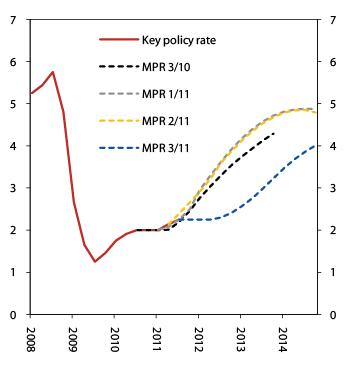
Figur 5.3 1 Key policy rate in baseline scenario MPR 3/10, MPR 1/11, MPR 2/11 and MPR 3/11. Percentage points. 2008 Q1–2014 Q4.
1 Figure 5.3 is identical to Figure 2.2 in the 2011 Annual Report of Norges Bank.
Kilde: Norges Bank
“Developments abroad and in financial markets imply slower growth in output, employment and lower inflation at home. Furthermore, in a situation with elevated uncertainty, it may be appropriate to take measures to mitigate effects of a particularly adverse outcome on the economy. The Executive Board is of the view that it is appropriate to reduce the key policy rate now in order to guard against an economic setback and even lower inflation”.
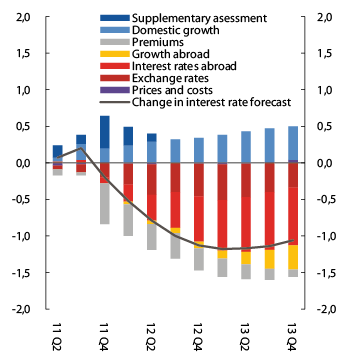
Figur 5.4 1 Change in the forecast for the key policy rate from Monetary Policy Report 3/10 to Monetary Policy Report 3/11. Percentage points. 2011 Q2–2013 Q4.
1 Figure 5.4 is identical to Figure 2.3 in the 2011 Annual Report of Norges Bank.
Kilde: Norges Bank
Figure 5.4 shows the changes in the key policy rate forecast from Monetary Policy Report 3/10 to Monetary Policy Report 3/11. The bars illustrate Norges Bank’s view during this period of the influence of various factors on inflation, output and employment. Throughout 2011, Norges Bank reduced the key policy rate forecast and postponed rate increases. The prospect of lower key policy rates abroad, a stronger krone and weaker growth prospects abroad pulled the interest rate forecast down in 2011.
5.3.3 Details of developments in inflation, output, employment, the exchange rate and inflation expectations
CPI will often vary considerably from one month to the next, particularly as a result of large fluctuations in electricity prices. In various indicators of underlying price growth, attempts have been made to eliminate changes in consumer prices resulting from passing disruptions. Price growth adjusted for tax changes and excluding energy products (CPI-ATE) is one such measure. Moreover, since 2008, Norges Bank has also calculated the CPIXE indicator of underlying inflation. In this indicator, CPI is adjusted for tax changes and temporary changes in energy prices, while any trends in energy price changes are registered. Norges Bank also reports the development of CPI adjusted for the frequency of price changes (CPI-FW), a trimmed average and a model-based indicator of underlying price growth (CPIM).
In the October 2010 Monetary Policy Report, Norges Bank assumed that both CPI and CPI-ATE growth would be 1¼ percent in 2011, while CPIXE growth would be 1½ percent. In the October 2011 Monetary Policy Report, Norges Bank adjusted the price estimates to CPI growth of 1½ percent, CPI-ATE growth of 1¾ percent and CPIXE growth of 1½ percent.
The growth in consumer prices (CPI) averaged 1.2 percent from 2010 to 2011, down from 2.5 percent the previous year. In the last 10 years, CPI has increased by 1.8 percent annually, on average. CPI-ATE and CPIXE grew by 0.9 and 1.1 percent respectively from 2010 to 2011.
Figure 5.5 shows the growth in consumer prices in recent years.
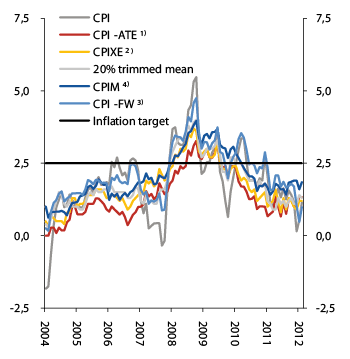
Figur 5.5 1 Consumer prices. 12-month change. January 2004–February 2012. Percent.2
1 Figure 5.5 is identical to Figure 1.8 in Monetary Policy Report 1/12 by Norges Bank.
2 CPI-FW = CPI adjusted for frequency of price changes. See “Economic commentaries” 7/2009 by Norges Bank.
Kilde: Statistics Norway and Norges Bank
In its 2011 Annual Report, Norges Bank wrote, among other things, the following regarding the inflation trend over time:
“In accordance with Norges Bank´s mandate for monetary policy, the operational target of monetary policy is an annual rise in the consumer price index (CPI) of close to 2,5% over time. CPI inflation over a short period does not provide an adequate basis for assessing whether monetary policy objectives have been achieved over time (…) Over the past ten years, average annual CPI inflation has been 1,8%. The deviation from the inflation target of 2,5% is the result of a number of favourable supply-side shocks to the economy earlier in the decade, including strong growth in productivity, an ample supply of labour from other countries and lower price rises for imported goods. This is reflected in strong growth in the Norwegian economy coupled with a period of lower-than-expected inflation”.
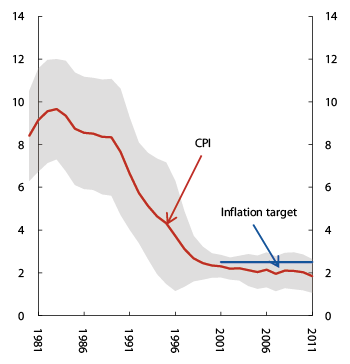
Figur 5.6 1 Inflation. Rolling 10-year moving average2 and variation3 in CPI. Percent. 1981–2011.
1 Figure 5.6 is identical to Figure 2.12 in the 2011 Annual Report of Norges Bank.
2 The moving average is calculated 10 years back.
3 The band around the CPI is the variation in the CPI adjusted for tax changes and excluding energy products in the average period measured by +/– one standard deviation.
Kilde: Statistics Norway and Norges Bank
If participants in the economy have confidence that the central bank will achieve its inflation target, they will expect inflation to equal the target in the long term. In its 2011 Annual Report, Norges Bank stated the following, among other things:
“Confidence in achieving the inflation target is a precondition for the stabilising effect of monetary policy on developments in output and employment. Inflation will not be at target at all times, but if there is confidence in monetary policy, expected inflation will be close to the inflation target over time, which in itself contributes to stabilising inflation”.
Perduco conducts quarterly surveys for Norges Bank, including of inflation expectations. Figure 5.7 shows the development in expected price growth in recent years. In the first quarter of 2012, economists expected consumer price growth of 2.4 percent in two years’ time and 2.7 percent in five years’ time. At the same time, the employer and employee organisations expected price growth of 2.0 percent in two years’ time and 2.4 percent in five years’ time. Households have normally had an estimated price growth somewhat higher than this.
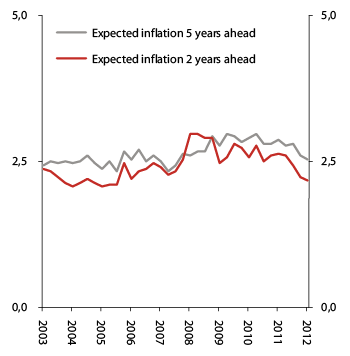
Figur 5.7 1 Expected consumer price growth, two and five years ahead.2 Percent. 2003 Q1–2012 Q1.
1 Figure 5.7 is identical to Figure 1.10 in Monetary Policy Report 1/12 by Norges Bank.
2 Average of expectations of employer and employee organisations and economists (financial industry experts and academia).
Kilde: TNS Gallup, Perduco and Norges Bank
Information about price expectations among market participants can also be obtained from the yield curve and from long-term forward rates in the interest rate market. According to Norges Bank, the fact that Norway’s inflation target is higher than that of the Euro area suggests that the difference between the long-term forward rates in Norway and in the Euro area should normally be around 0.5–1 percentage points, depending on the size of the risk premium in the interest rate market. Throughout 2011, this difference was close to one percentage point. In the first half of the year, the difference was a little smaller, but increased in the course of the year, not least due to the prospect of very low interest rates abroad. In its 2011 Annual Report, Norges Bank wrote the following in this connection:
“A wider spread can be an indication that price expectations in Norway are higher than implied by the inflation target. Overall, the indicators suggest that there is confidence that inflation over time will be close to 2,5%”.
Norges Bank uses a calculated output gap to express its assessment of the total capacity utilisation in the economy. The output gap illustrates deviations between the actual level of GDP for mainland Norway and a calculated normal level. In 2011, all of the Monetary Policy Reports calculated that the output gap for mainland Norway was zero on average for 2011. Figure 5.8 shows Norges Bank’s calculated output gap trend and the variation in the output gap from 1981 to 2011. The variation is illustrated by means of the band around the output gap. In its 2011 Annual Report, Norges Bank wrote that, when measured in this way, the fluctuations in the economy in the last 10 years are on average slightly smaller than in the years around 1990. Nevertheless, the effects on output in the autumn of 2008 and spring of 2009 were more pronounced than for several years.
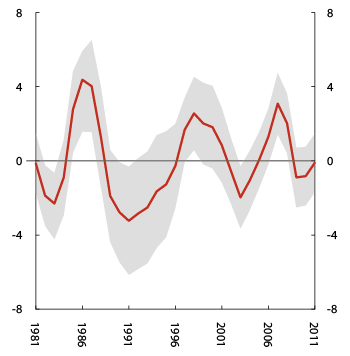
Figur 5.8 1 Output gap estimates. Level2 and variation3. Percent. 1981–2011.
1 Figure 5.8 is identical to Figure 2.13 in the 2011 Annual Report of Norges Bank.
2 The output gap measures the difference between actual and estimated potential GDP for mainland Norway.
3 The band shows the variation in the output gap measured by +/– one standard deviation. The standard deviation is calculated over a 10-year period; seven years back and two years forward.
Kilde: Norges Bank
There is great uncertainty about the calculation of the output gap. In Inflation Report 3/2006, Norges Bank wrote the following, among other things:
“The output gap is not observable and must be estimated. There is considerably uncertainty surrounding the estimates, not only the estimates of the future output gap but also today´s output gap. Different calculation methods produce different estimates of the output gap(...). Each method has its strengths and shortcomings and it is not obvious which method provides the best indication of resource shortages. In addition to methodology uncertainty, estimates of the output gap are uncertain due to data uncertainty(...).”
Norges Bank has stated that this makes it necessary also to utilise other indicators when assessing capacity utilisation in the economy.
The international financial crisis has contributed to large fluctuations in the krone in recent years. Measured by means of the trade-weighted exchange rate index, the krone weakened by some 18 percent in the second half of 2008; see Figure 5.9. In the course of 2009, this development was largely reversed, and at the end of the year the krone was 14 percent stronger than at the start of the year. In 2010 and 2011, the krone strengthened further, by 4.2 percent and 1.9 percent respectively. The average krone level last year was 4.4 percent stronger than the average for the 10-year period 2002–2011.
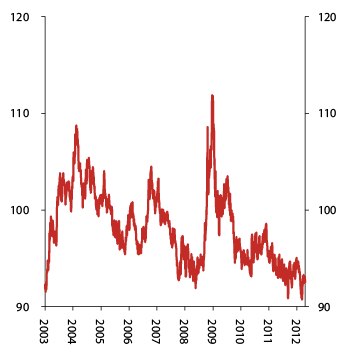
Figur 5.9 The krone. The trade-weighted krone exchange rate. 1 January 2003–18 April 2012.
5.4 Other parties’ assessments of Norges Bank’s conduct of monetary policy
Several reports have been made on how monetary policy in Norway has been applied in the period following the presentation of the Financial Markets Report 2010 in April 2011. The following section briefly discusses the assessments in the following reports:
“Norges Bank Watch 2012” – a report by a group of experts appointed by the Centre for Monetary Economics (CME) at BI Norwegian Business School. The Ministry of Finance helped to fund this report to improve the basis for the Ministry’s assessment of monetary policy in this report.
The OECD’s country report on Norway, which was presented on 15 February 2012.
The IMF’s report of 2 February 2012, which was prepared in connection an Article IV consultation.
“Financial prospects 2012” by the Norwegian Financial Supervisory Authority, which was presented on 13 March 2012. The report discusses the role of monetary policy in assessments of the prospects of financial stability.
The Norges Bank Watch 2012 report stated the following about the conduct of monetary policy in 2011, among other things:
“Given the significant uncertainties about developments in the world economy and the dilemma of how to balance various risks, it is difficult to argue that Norges Bank has made any major mistakes. The key policy rate was increased in the first half of 2011 when economic growth was gaining momentum, and it was reduced again in December after the economic outlook had worsened.
That being said, whether one sees monetary policy in Norway as well balanced during 2011 or not depends on whether financial stability should be viewed as an independent objective for the central bank or not. If an extra weight should be given to financial stability in monetary policy (…) Norges Bank could, in principle, have raised the interest rate earlier and more during the first half of 2011. The cut in December could then be questioned. But if one does not accept that financial stability should be an objective for monetary policy in addition to the objective of stabilising output and inflation over the medium term, it is easier to come to the conclusion that monetary policy in 2011 was well balanced.
(…) We conclude that there is considerable room for improvement in Norges Bank’s communication of monetary policy. In particular, the role of financial stability for monetary policy needs to be clarified.”
The Norges Bank Watch group wrote that the Bank should generally clarify what role financial stability plays in the conduct of monetary policy. This applies, for example, to how changes in risk premiums influence the Bank’s economic forecasts and interest rate decisions.
The group also pointed out that Norges Bank’s formal mandate with regard to macroregulation of the financial markets is unclear. The group took the view that Norges Bank, and not the Norwegian Financial Supervisory Authority, should be responsible for macroregulation of the finance sector.
The Norges Bank Watch group also discussed Norges Bank’s independence, and was of the opinion that, among other things, the duty to submit and power to issue instructions should be repealed.
In the OECD’s most recent Economic Survey for Norway, which was presented on 15 February 2012, the OECD wrote, among other things:
“Although the annual consumer price inflation target of ”close to 2½ per cent over time” has not always been met over the last 6 years, the shortfall has been mostly on the downward side, so expectations of low inflation are likely to be well-anchored. Keeping policy interest rates low, as the current situation requires, thus poses little risk to inflation”.
In the IMF’s report of 2 February 2012 in connection with the most recent Article IV consultation with Norway, the organisation wrote the following about Norges Bank’s conduct of monetary policy:
“... the current monetary stance remains appropriate. The current policy rate is broadly in line with both calibrated and estimated Taylor rules, as below-target inflation and a closed output gap imply that the current policy rate should remain below its steady state level, which is estimated to be 4½ percent. Moreover, the slight gap between the Taylor rule and the current policy rate can be explained by the standard Taylor rule’s failure to take into account financial sector stress conditions, which are currently elevated and thus justify a policy rate slightly below the standard Taylor rule level”.
In the Financial Prospects 2012 report, published on 13 March 2012, the Norwegian Financial Supervisory Authority assessed Norway’s economic development prospects. Among other things, the report stated the following about the effect of interest rate policy on the Norwegian economy:
“In recent years household finances have been marked by a growing debt burden, high loan to value ratio son home mortgage and greater recourse to interest-only borrowing, driven by low interest rates, positive expectations of personell finances and belief in a continued rise in house prices. This has contributed to pushing debt and house prices to a very high level in historical terms. The international downturn has encouraged to pushing debt and house prices to a very high level in historical terms. The international downturn has encouraged expetcations that interest rates will remain low for a long period in Norway as elsewhere. This, along with expectations of continued high income growth, is sustaining the demand for loans”.
The Norwegian Financial Supervisory Authority wrote the following about Norges Bank’s new quota system for banks’ deposits with the central bank:
“Norway´s interbank market has functioned satisfactorily. Norges Bank introduced a quota system for central bank deposits in October 2011 whereby deposits in excess of the individual bank´s alloted quota yield far lower interest than deposits within the quota. The system accordingly makes large deposits in Norges Bank financially unfavourable, and was introduced with a view to stimulating the interbank market.”
Chapter 2 of this report contains a more detailed discussion of the prospects of financial stability in Norway.
5.5 The Ministry’s evaluation of Norges Bank’s conduct of monetary policy
The monetary policy guidelines laid down on 29 March 2001 remain in place. There was broad agreement in the Storting on the monetary policy guidelines. It seems that market participants, academics and the general public all have confidence in Norwegian monetary policy. Norges Bank is mandated to exercise case-by-case discretion within the framework of the guidelines. In the Ministry’s view, the division of responsibility between the political authorities and Norges Bank achieves the desired purpose.
The Ministry is of the opinion that the current monetary policy guidelines provide a good framework for Norges Bank’s conduct of monetary policy, and that they have proven themselves to be robust even during the financial crisis. The guidelines enabled Norges Bank to cut interest rates sharply when inflation expectations and output dropped in the autumn of 2008. The expansive monetary policy has helped materially to stabilise the development of the Norwegian economy. The framework is highly consistent with practice in other countries which employ flexible inflation targeting.
The Regulation on Monetary Policy states that monetary policy shall be aimed at stability in the Norwegian krone’s national and international value. Monetary policy shall be oriented towards low and stable inflation. The operational target of monetary policy shall be annual consumer price growth of approximately 2.5 per cent over time. Monetary policy shall also support fiscal policy by contributing to stable developments in output and employment, and create stable expectations regarding the development of the exchange rate.
Norway’s budget policy and monetary policy must work together to promote the stable development of output and demand. The economic policy guidelines imply that monetary policy has a clear role to play in stabilisation policy. Monetary policy instruments can quickly be changed if the economic prospects change.
Monetary policy shall be forward-looking. Norges Bank sets the interest rate with the aim of stabilising inflation close to the target in the medium to long term. The relevant time horizon depends on the disruptions to which the economy is exposed, and what effects such disruptions have on inflation and the real economy looking forward. In applying monetary policy, Norges Bank has to weigh the consideration of stable inflation against the consideration of stability in output and employment in the short to medium term.
Consumer price development in Norway varies considerably from one year to the next, not least due to large variations in electricity prices. Consumer prices (CPI) increased by 1.2 percent from 2010 to 2011, following a price increase of 2.5 percent the previous year. Consumer price growth has averaged 1.8 percent over the last 10 years and 2.1 percent over the last five years, i.e. somewhat lower than the inflation target in set in the monetary policy.
When assessing price trends over time, it is the development in total CPI which is the key measure. However, when assessing current inflation and the prospects of further price growth, CPI, in its form at that specific time, does not provide the best assessment basis. In various indicators of underlying price growth, attempts have been made to eliminate changes in consumer prices resulting from passing disruptions which should be ignored when setting the interest rate; see the discussion above. Norges Bank uses several indicators to obtain a picture of underlying inflation, such as consumer prices adjusted for tax changes and excluding energy products (CPI-ATE), and CPIXE, which takes account of trends in the development of energy prices. Norges Bank calculates CPIXE itself, and publishes price growth measured using this indicator on the same day as CPI is published. In 2011, CPI-ATE grew by 0.9 percent, 0.5 percentage points lower than in the previous year. CPIXE increased by 1.1 percent from 2010 to 2011.
Expectations regarding inflation several years ahead appear to be firmly incorporated into the inflation target; see section 5.3.3 above. Such confidence in the inflation target makes it easier for Norges Bank to contribute to stability in output and employment; see the Regulation on Monetary Policy. The low price growth in 2011 does not indicate a risk of deflation in the Norwegian economy. Activity growth in mainland Norway was higher in 2011 than in 2010, and close to the average over the past 40 years. Unemployment is low, both historically speaking and in comparison with other countries. Accordingly, Norges Bank has stated that, rather than lowering the key policy rate even further, it will use somewhat more time to achieve the inflation target.
Norway coped with the financial crisis and the subsequent setback in the global economy better than most other countries. There appear to be several reasons for this. This time Norway’s industrial structure enabled the Norwegian economy to stand up well to the setback in the USA and Europe. As an exporter of energy and raw materials, Norway has profited from strong growth in demand from China and other emerging economies. In addition, Norway’s monetary and finance policy helped to stabilise developments. Since most residential mortgages in Norway have variable interest rates, Norges Bank’s interest rate cuts from the autumn of 2008 to the summer of 2009 quickly resulted in increased purchasing power. GDP growth in mainland Norway was 1.9 percent in 2010 and 2.6 percent in 2011.
As a result of improved prospects for the Norwegian economy, Norges Bank was among the first central banks internationally to increase the interest rate again after the financial crisis. From October 2009 until May 2011, Norges Bank raised the interest rate from 1.25 to 2.25 percent. During the summer and autumn, both international prospects and the prospects of the Norwegian economy weakened. The central banks of many other countries cut their key policy rates, including by ½ percentage point in the Euro area. Accordingly, Norges Bank decided in December last year to reduce the interest rate again, by 0.50 percentage points, to 1.75 percent. In the new year (14 March), the key policy rate was cut further, by 0.25 percentage points. The situation of Norway’s most important trade partners is now such that their interest rates are likely to remain at a very low level for some time. This in turn influences Norges Bank’s deliberations in connection with setting the interest rate. The interest rate path which Norges Bank published in connection with the interest rate meeting on 14 March of this year indicates that interest rates will also remain low in Norway for the next three years, although a gradual increase is expected.
Turbulence in the international financial markets has resulted in a higher-than-normal difference between the three-month money market rate and the key policy rate expected by market participants. Moreover, in Norway, the difference was greater than in many other countries. This was one important reason for Norges Bank’s initiative vis-à-vis the finance industry to improve the rules on NIBOR-setting, and for the Bank’s decision to change the system for managing liquidity with the aim of reducing demand for central bank liquidity and promoting increased activity in the inter-bank markets; see the discussion above. Against this backdrop, Finance Norway introduced new rules for the setting of NIBOR, in force from 1 August 2011, while Norges Bank’s new liquidity management system was implemented on 3 October 2011. Looking forward, it will be important to see whether these measures work as intended.
According to the regulations, monetary policy is to contribute to stability in the international value of the krone, and help to stabilise expectations regarding exchange rate developments. The operational target of monetary policy is low, stable inflation. Accordingly, no particular target has been set for the level of the krone exchange rate. Nevertheless, developments in the krone exchange rate influence the setting of the interest rate, as the exchange rate influences inflation and output, particularly in small, open economies like the Norwegian economy.
The value of the Norwegian krone has fluctuated considerably in connection with the turbulence in the financial markets in recent years. The krone weakened markedly in the second half of 2008, although the majority of this drop was reversed in 2009. In 2010 and 2011, the krone strengthened by 4.2 percent and 1.9 percent respectively. This upward trend has continued in 2012.
Monetary policy and finance policy must work together to stabilise output and employment trends. If only Norway has a high interest rate, the krone may strengthen, a development which would particularly hit industries exposed to international competition. The government is giving priority to pursuing a budget policy which helps to ensure the balanced development of the Norwegian economy and that the interest rate is not unnecessarily high. In isolation, this will reduce the pressure on enterprises which are exposed to international competition
Clear communication of the intentions behind the monetary policy focus also helps to stabilise expectations regarding the development of the exchange rate. Norges Bank’s publication of its own future interest rate path is an important part of this communication.
The work done to ensure financial stability in Norway is distributed among the Ministry of Finance, Norges Bank and the Norwegian Financial Supervisory Authority. Along with the Norwegian Financial Supervisory Authority, Norges Bank is mandated to help ensure that the financial system is robust and efficient, and therefore monitors financial institutions, the securities markets and payment systems to uncover elements which could threaten stability. Norges Bank is also a lender of last resort for banks. Chapter 2 of this report describes the work done on financial stability in more detail. The chapter also describes the new guidelines on responsible lending practices in connection with residential mortgages which the Norwegian Financial Supervisory Authority adopted in December of last year. These guidelines may curb, to some degree, the interplay between credit growth, income growth and interest rates which has been observed in recent years.
The Ministry of Finance is considering measures to improve macroprudential supervision of systemic risk in Norway, including with the input of a working group appointed by the Ministry to examine the best design for macroregulation of the Norwegian finance sector. In its report, the group discussed a number of instruments which may be relevant in the context of macroregulation, with a particular emphasis on the introduction of a counter-cyclical capital buffer, i.e. an additional requirement relating to pure tier 1 capital which is to vary with economic cycles. The group proposed that Norges Bank should be responsible for developing a basis for deciding the size of the counter-cyclical capital buffer which is to be maintained by Norwegian financial institutions. The reasons given for this proposal include that Norges Bank already has many resources available for use in assessing macroeconomic connections. The Ministry of Finance will return to this question; see the detailed discussion in Chapter 3 of this report.
As discussed in Chapter 2, both house prices and household debt have risen sharply in Norway for a number of years. Developments in debt levels, asset prices and the ability of borrowers to repay debt have long been included in the basis for Norges Bank’s setting of the interest rate. Among other things, the central bank has stated that, in order to take account of the fact that potential imbalances in asset prices may disrupt activity and inflation for some time into the future, the Bank may adopt a long-term perspective as regards achieving the inflation target.
Starting in Monetary Policy Report 1/12, which was presented on 14 March of this year, Norges Bank has included the consideration of financial stability as a separate part of its loss function. This has been achieved by explicitly including the principle that the interest rate should not deviate too much from its normal level. Norges Bank wrote that this consideration may reduce the risk of financial imbalances developing. The loss function already reflected Norges Bank’s tasks of contributing to low, stable inflation and a stable development of output and employment. The central bank’s desire to take longer to achieve the inflation target also means an increased emphasis on the output gap in the loss function. This may also improve financial stability, as financial imbalances often build up during periods of high capacity utilisation. The consideration of financial stability must be weighed against the other considerations laid down in Norges Bank’s mandate, and there are limits to what can be achieved through a single instrument.
It is important to households and other participants in the economy that communications from Norges Bank clearly describe the assessments which underpin interest rate decisions, and how the Bank sees future interest rate developments, so that households and other participants can adapt in a manner beneficial to them. Norges Bank’s practice of publishing its own interest rate forecast, adopted in the autumn of 2005, has had a positive effect in this context. Norges Bank has attracted international notice due to its emphasis on good, open communications with the public about the assessments which underpin the conduct of monetary policy, and the Bank has continued to develop this aspect in recent times. Among other things, Norges Bank writes about what the Executive Board has emphasised in the assessments which underpin its interest rate decisions, and states whether alternatives have been considered in relation to the interest rate. As of Monetary Policy Report 1/11, the Monetary Policy Reports have included an introductory chapter which discusses the assessments and discussions of the Executive Board at its meeting two weeks before the interest rate meeting. Starting in Monetary Policy Report 3/11, the introductory chapter has also included the discussions of the Executive Board at the interest rate meeting held between Monetary Policy Reports.
Following an overall evaluation, the Ministry sees no grounds for commenting on Norges Bank’s conduct of monetary policy in 2011.